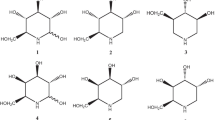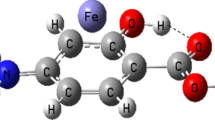Abstract
In order to understand the influences of the modification of E-ring on the main frame of camptothecin (CPT), studies of the E-ring modification resulted changes in the stability and the electrostatic potential around the main frame of CPT were performed by the density functional theory. The results of present study indicate that the stability of the close-ring lactone form of CPT and homocamptothecin (hCPT) is similar to their open-ring hydroxylate forms, especially when in aqueous solutions. As an E-ring-modified CPT analogue, hCPT has essentially the same electrostatic potential (ESP) as CPT around the main frame (from A- to D-ring). However, the electrostatic potentials of the open-ring compounds are more negative around the main frame than that of CPT. The changes in the ESP of the CPT derivatives are found to be correlated with the corresponding dipole moments. Since electrostatic potential could influence the π–π stacking pattern between CPT (and its analogues) and the DNA bases, present study suggests that this π–π interaction of the open-ring forms of CPT and hCPT might be different from that of the close-ring lactone form. The information revealed in this study sheds light on the developments of new CPT-type antitumor drugs.




Similar content being viewed by others
References
Thomas CJ, Rahier NJ, Hecht SM (2004) Bioorg Med Chem 12:1585–1604
Hartmann JT, Lipp HP (2006) Drug Saf 29:209–230
Hsiang Y, Hertzberg R, Hecht S, Liu LF (1985) J Biol Chem 260:14873–14878
Hsiang Y, Lihou MG, Liu LF (1989) Cancer Res 49:5077–5082
Jaxel C, Kohn KW, Wai MC, Wall Mo E, Pommier Y (1989) Cancer Res 49:1465–1469
Fan Y, Shi LM, Kohn KW, Pommier Y, Weistein JN (2001) J Med Chem 44:3254–3263
Staker BL, Hjerrild K, Feese MD, Behnke CA, Burgin AB, Stewart L (2002) Proc Natl Acad Sci USA 99:15387–15392
Kerrigan JE, Pilch DS (2001) Biochemistry 40:9792–9798
Fan Y, Weinstein JN, Kohn KW, Shi LM, Pommier Y (1998) J Med Chem 41:2216–2226
Lesueur-Ginot L, Demarquay D, Kiss R, Kasprzyk PG, Dassonneville L, Bailly C, Camara J, Lavergne O, Bigg DCH (1999) Cancer Res 59:2939–2943
Chauvier D, Chourpa I, Maizieres M, Riou J-F, Dauchez M, Alix AJP, Manfait M (2003) J Mol Struct 651–653:55–65
Demarquay D, Huchet M, Coulomb H, Lesueur-Ginot L, Lavergne O, Camara J, Kasprzyk PG, Prevost G, Bigg DCH (2004) Cancer Res 64:4942–4949
Xiao X, Cushman M (2005) J Org Chem 70:9584–9587
Xiao X, Cushman M (2005) J Am Chem Soc 127:9960–9961
Beck AD (1993) J Chem Phys 98:5648–5652
Lee C, Yang W, Parr RG (1988) Phys Rev B 37:785–789
Zhao Y, Truhlar DG (2008) Acc Chem Res 41:157–167
McLean AD, Chandler GS (1980) J Chem Phys 72:5639
Krishnan R, Binkley JS, Seeger R, Pople JA (1980) J Chem Phys 72:650
Cossi M, Barone V, Cammi R, Tomasi J (1996) Chem Phys Lett 255:327–335
Frisch MJ et al (2010) Gaussian 09, (version b.01). (Gaussian, Inc., Wallingford CT)
Acknowledgments
This research was supported by National Natural Science Foundation of China (30772586) and Jiangsu Natural Science Foundation of China (BK2009071).
Author information
Authors and Affiliations
Corresponding authors
Additional information
Dedicated to Professor Guosen Yan and published as part of the special collection of articles celebrating his 85th birthday.
Rights and permissions
About this article
Cite this article
Lei, J., Chen, Y., Feng, X. et al. Electrostatic potentials of camptothecin and its analogues. Theor Chem Acc 133, 1542 (2014). https://doi.org/10.1007/s00214-014-1542-1
Received:
Accepted:
Published:
DOI: https://doi.org/10.1007/s00214-014-1542-1




